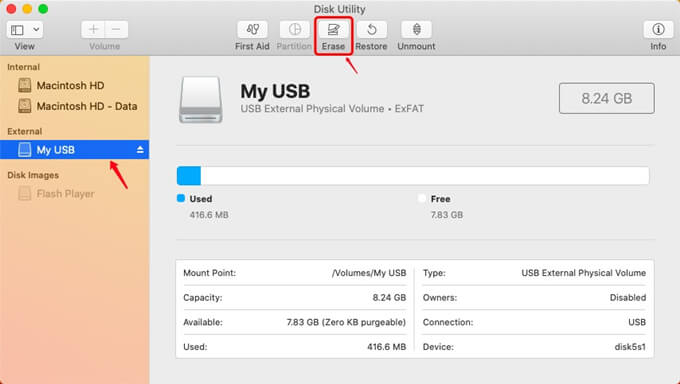Format Flash Drive Mac Exfat
Manuel Manev wrote:
If you work in an environment where you constantly use a flash drive between a Windows and Mac computer, you may find that you constantly have to format USB drive. One way to permanently solve this problem is to format usb flash drive to exFAT, a platform-independent file system. Fortunately, there is a file system (actually two, I’ll explain) that you can format your flash drive to be fully compatible with Mac and PC. In other words, you can access the drive and transfer data without any hassles. That file system is — exFAT. When finished, the drive will be formatted and repartitioned successfully. Click the Done button. NOTE: exFAT is used on SDXC card (64GB and higher). NOTE: exFAT can be used on flash drives or memory cards to transfer files larger than 4GB. NOTE: MacOS 10.6.2 or higher is required for exFAT file system. ExFAT is a file system used mainly for formatting flash drives such USB memory sticks and SD cards. However, it’s also widely used on all sorts of other consumer electronic devices such as digital cameras, TVs, media centers, cable TV set-top boxes and so on. Is exFAT faster or slower than FAT32 and NTFS? For instance, there are two methods to help you format a corrupted USB flash drive to exFAT on Mac. Of course, you also can rescue your data with a reliable data recovery solution. Two methods to format corrupted USB flash drive to exFAT on Mac. To fix the corrupted USB flash drive, you may choose to format the USB flash drive.

Hi, so I have a flash drive and I want to formate it into exFAT/NTFS. I go and do everything, but then I got MS-DOS (FAT). Also I do not have option for NTFS. I apply 2 screenshots so that to see what is happening here...
I can't say if that's the internal logic in Disk Utility at work, but since the main benefit of exFAT over FAT is the ability to save files larger than 4GB, and the flash drive you're working on is only 4GB in size, there's no reason not to just leave it as FAT. Moreover, Disk Utility is known to have problems with exFAT formatting (the recommendation is to do it on a Windows PC), so you're better off as is. Finally, the Mac OS can read but not write to NTFS drives so being able to format a drive as NTFS would be counter-productive.
Apr 7, 2015 9:03 AM

Disk Utility User Guide
In Disk Utility, you can format an external disk that you can use with both a Microsoft Windows-based computer and a Mac. For example, you might want to do this if you use a flash drive to store data files you need to use on your Mac at home and when using a Windows-based computer at school or the public library.
How To Format Usb Exfat
WARNING: Formatting a disk or volume erases all the files on it. Save any files you need to another volume before formatting.
In the Disk Utility app on your Mac, choose View > Show All Devices.
If Disk Utility isn’t open, click the Launchpad icon in the Dock, type Disk Utility in the Search field, then click the Disk Utility icon .
In the sidebar, select the disk you want to format to use with Windows computers.
Click the Erase button in the toolbar.
In the Erase dialog, click the Scheme pop-up menu, then choose a partition scheme.
Click the Format pop-up menu, then choose one of the following:
MS-DOS (FAT): Choose this format if the size of the disk is 32 GB or less.
ExFAT: Choose this format if the size of the disk is over 32 GB.
Enter a name for the volume.
The maximum length for the volume name is 11 characters.
Click Erase, then click Done.